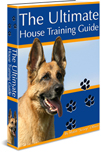
The Ultimate House Training Guide
The Ultimate House Training Guide
What Is It?
This handy manual is a comprehensive guide to what’s arguably the most widespread, challenging and frustrating issue faced by any and all dog-owners: house training. Has any aspect of dog ownership ever been so widely misunderstood and unanimously dreaded?
Theories both unhelpful and just plain wrong positively abound on the topic.
You can find a veritable vortex of conflicting arguments almost anywhere you choose to seek information on the subject, whether it’s online (o, the staggering variation on the “The Only Way To House train Your Dog!” theme to be found here!), at your local library, through contact with dog trainers, or through the (less reputable but nevertheless prolific) ranks of “quack” dog trainers :
aka, those frustrating people sans qualifications, but with enough smugness and pseudo-savoir faire to fool the less suspicious of us into handing over our hard-earned dosh.
The Ultimate House Training Guide. What Sets This Book Apart?
After several confounding and increasingly-frustrated hours spent trawling through the virtual minefield of conflicting information on this subject, it was with a heady mixture of joy and near-tearful relief that I stumbled across an online book entitled “The Ultimate House Training Guide”, by Martin Olliver.
As the title suggests, literally all aspects of the subject are covered, and in a manner both chatty and educational – it’s kind of like having a friendly conversation with a knowledgeable canine behaviorist (with the added benefit of being able to refresh your understanding of the matter at any given time, simply by scrolling back to the relevant section!)
The tone of the book presents a welcome contrast to the illogicalities so freely available elsewhere on the Net (and, indeed, in most repositories of canine “expertise”): it’s friendly, informative, and above all, commonsensical. No gimmicky recommendations, poorly-disguised marketing ploys, or too-brief Q&A sessions here: you don’t have to be experienced in canine behavior and training to see that this guy knows what he’s talking about (and did I mention he’s a vet?)
The Ultimate House Training Guide. What’s Actually Included?
There’s a quick section on the tools of the trade (“patience, persistence, consistence, and common sense”) along with some morale-boosting advice on how to keep your cool through the training process, and then it’s straight into the meat of the matter: the nitty-gritty on how to house train, with a detailed section (one for pups, one for older dogs) on each of the three methods recommended (paper-training, crate-training, and the direct method.)
Common house training problems are dealt with next – this is particularly handy! A huge variety of issues are covered, from territorial marking to poop-eating; and on top of that, each problem comes with a case study, which helps you to put the information into context.
Next, health-related problems are covered in some depth. There’s a section on congenital problems (problems your dog was born with); a section on the disease-related problems that develop later in life; and a section on other problems related to house training, like inappropriate outdoor elimination, or lawn-burn from urination.
Finally, there’s the Top Ten Tips for hassle-free house training, which is essentially a recap of the most helpful and necessary attitude adjustments, practical tips, and useful nuggets of general knowledge which will come in most handy in your dog’s training.
The Ultimate House Training Guide. Just Because It’s Detailed Doesn’t Mean It’s Confusing
Sound like a handful? It’s actually very user-friendly. Not only is this book packed with sound practical advice, but the whole thing is laid out in a very logical and easy-to-understand format: the tone is light and non-threatening (no confusing terminology or strange gaps in logic here!) and it proceeds in a logical manner from step to step, with the assistance of helpful how-to illustrations from the book’s charming mascot (a pooch called, of all things, Spot-Less).
Troubleshooting
In my opinion, one of the best parts: a free, personalized email consultation with the team at Kingdom of Pets. If you’d like additional help with your own dog’s toilet-related vagaries, just flick them off an email and you’ll get an individualized professional opinion on how best to handle the problem - plus any additional tips and strategies necessary to get your house training under control.
The Ultimate House Training Guide. The Verdict
House training a dog is an intimidating task for most people, but the author’s depth of knowledge is pretty reassuring; and he certainly knows how to break it down for even the greenest of owners. In addition to the main sections detailed above, there are plenty of tempting extras included to make the process as easy and effective as possible: checklists, do’s and don’ts, how to appropriately deal with “accidents”, even a list of the more helpful training products available!
All in all, two thumbs up from me:
when the information on hand is as detailed, easy to absorb, and - above all – reliable as The Ultimate House Training Guide, you really can’t go wrong. May your dog’s initiation to house training proceed Spot-Lessly!
The Ultimate House Training Guide
